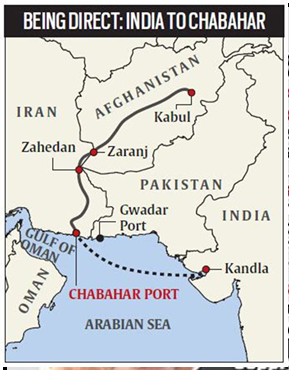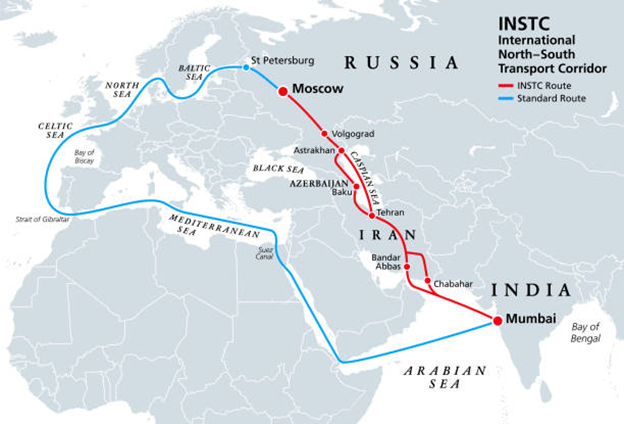CHABAHAR, PORT OF A SMART CALL
Relevance: GS 2 – Bilateral, regional and global groupings and agreements involving India and/or affecting; India’s interests; Effect of policies and politics of developed and developing countries on India’s interests, Indian diaspora.
Why in the news?
- Investing in Chabahar poses challenges due to historical US sanctions affecting progress in the region.
- Since 2018, India has reduced significant imports of heavy Iranian crude, impacting bilateral relations.
- Sanctions hindered financial aid for constructing the Chabahar-Zahedan railway in 2020.
- Energy trade has traditionally been vital to India-Iran relations, but this shift strained ties temporarily.
Recent developments between India and Iran
- India and Iran recently signed a 10-year development and operation contract for Chabahar Port.
- The agreement involves India Ports Global Ltd (IPGL) and Ports and Maritime Organisation (PMO) of Iran.
- IPGL will invest $120 million in developing the Shahid Beheshti Port Terminal at Chabahar.
- Additionally, India’s Ministry of External Affairs (MEA) will provide a $250 million credit line to enhance infrastructure connectivity in the Chabahar region.
- The aim is to strengthen Chabahar’s role as a regional connectivity hub.
India-Iran Chabahar Agreement and INSTC
- The new agreement replaces the annual renewal system of the 2016 operation agreement for Chabahar Port.
- Its aim is to strategically enhance and diversify value chains for both India and Iran.
- Chabahar Port serves as a flagship project for bilateral cooperation and is a vital maritime node in the International North-South Transport Corridor (INSTC).
- INSTC is a 7,200 km-long multimodal connectivity initiative linking India to Europe via the Caucasus, Iran, Russia, and Central Asia.
- It is anticipated to reduce transit time between India and Europe by 40% and transit costs by 30%.
- The significance of INSTC has increased in response to the evolving Red Sea crisis.
India-Iran Cooperation in Chabahar Port Development
- Cooperation between India and Iran in developing Chabahar Port traces back to 2003, with formal talks progressing after the US lifted sanctions against Iran in 2015.
- This sanction relief enabled India to initiate investments in the strategically significant port.
- During Prime Minister’s 2016 state visit to Tehran, investments totaling $500 million were announced for equipping and operating the Shahid Beheshti terminal.
- The visit resulted in an annual operation contract between India and Iran, facilitating the operationalization of Shahid Beheshti.
- India Ports Global Ltd (IPGL) was designated to equip and commence operations at the terminal, with operations slated to begin in 2019.
- Since then, Chabahar Port has handled substantial container traffic, amounting to 90,000 TEUs, and over 4 million metric tonnes (MMT) of bulk and general cargo.
- Geographically, Chabahar holds strategic importance for India, located approximately 885 km and 1,265 km away from Kandla and Mumbai ports,
Chabahar and INSTC
- Chabahar serves as a critical maritime node along the eastern route of the International North-South Transport Corridor (INSTC).
- Its connectivity to resource-rich Central Asia and Afghanistan is facilitated by the Chabahar-Zahedan railway (expected to open in 2025) and the India-built Delaram-Zaranj highway.
- These connections offer new markets for India’s exports and diversified energy supply chains.
Geopolitical Dynamics and China’s BRI
- The agreement to develop Chabahar Port serves as a strategic move countering China’s Belt and Road Initiative (BRI) in the Indian Ocean region.
- Gwadar port, managed by China Overseas Ports Holding Company (COPHC), and Karachi have received significant Chinese investments totaling $4.7 billion between 2016 and 2023 as part of the BRI’s Maritime Silk Road (MSR) strategy.
- Chinese state-owned companies currently operate seven ports in South Asia and 17 ports in the Indian Ocean region.
Investing in Chabahar and its challenges
- By investing in Chabahar, India aims to decrease its reliance on Pakistan’s Gwadar and Karachi ports in the long term.
- It offers India the opportunity to diversify its supply chains efficiently, especially in a volatile geopolitical environment.
- However, investing in Chabahar presents challenges due to US sanctions, which have hindered regional development.
- India’s import of heavy Iranian crude ceased in 2018, and sanctions prevented financial assistance for the construction of the Chabahar-Zahedan railway in 2020.
- The temporary decline in bilateral relations between India and Iran underscores the historical significance of energy trade as a cornerstone of their relationship.
US Sanctions and India’s Efforts
- In 2018, Chabahar Port development gained exemption from sanctions due to Indian lobbying efforts and US recognition of its importance for Afghanistan.
- However, following the recent agreement signing, the US State Department reiterated warnings that countries enhancing economic ties with Iran could face potential future economic sanctions.
- While acknowledging India’s independent foreign policy and relations with Tehran, the State Department stressed the unwavering nature of its Iran economic sanctions policy.
- It clarified that the India-Iran port deal does not fall outside the scope of sanctions, reflecting Washington’s tougher stance on economic sanctions amidst Iran’s involvement in the West Asian crisis.
- Chabahar Port holds significance as the first overseas port managed by an Indian company, amplifying its importance.
- The engagement in Chabahar presents India with a strategic opportunity to establish a foothold in a geostrategically vital maritime node.
- Despite the risk posed by US sanctions, India views Chabahar as a crucial step forward in its maritime strategy.
Way Forward
- Diplomatic Engagement: Continue diplomatic efforts to engage with the US and other stakeholders to mitigate the impact of sanctions on Chabahar development.
- Multilateral Approach: Seek support from other countries and international organizations to advocate for waivers or exemptions from US sanctions for projects related to Chabahar Port.
- Economic Diversification: Explore alternative financing mechanisms and investment sources to reduce reliance on US financial systems and minimize exposure to sanctions risk.
- Infrastructure Development: Prioritize infrastructure projects like the Chabahar-Zahedan railway to enhance connectivity and logistical efficiency, thereby increasing the port’s attractiveness to international trade partners.
- Strategic Partnerships: Strengthen partnerships with countries like Iran, Afghanistan, and Central Asian nations to collectively address challenges and leverage mutual interests in Chabahar’s development.
- Risk Management Strategies: Develop comprehensive risk management strategies to assess and mitigate potential legal, financial, and geopolitical risks associated with Chabahar investments.
- Continued Dialogue: Maintain open channels of communication with the US and other stakeholders to address concerns, clarify intentions, and find mutually beneficial solutions for Chabahar’s development.
Associated Articles
- https://universalinstitutions.com/india-and-iran-sign-10-year-agreement-for-chabahar-port-operation/
- https://universalinstitutions.com/india-has-urged-central-asian-countries-to-use-the-port-of-chabahar/
Mains question
Discuss the significance of India-Iran cooperation in developing Chabahar Port amidst US sanctions. Assess its impact on regional geopolitics and India’s maritime strategy. (250 words)





